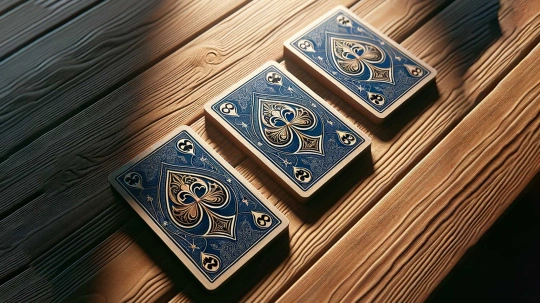Four of a Kind is one of the strongest combinations in poker. It consists of four cards of the same rank and one random card.
What is Four of a Kind in Poker?
Four of a Kind is one of the strongest combinations in poker. It consists of four cards of the same rank and one random card.
How often does Four of a Kind occur in Poker?
Four of a Kind is one of the rarest hands in poker. The probability of getting Four of a Kind in a five-card deal is approximately 0.024%. This means that Four of a Kind can occur roughly once in 4165 deals.
The likelihood of getting Four of a Kind in poker depends on several factors, including the number of players at the table and the number of cards dealt. In games with more players or cards, such as Texas Hold'em, the probability of getting Four of a Kind might be higher.
Considering the rarity of getting Four of a Kind in poker, your gameplay strategy should aim to maximize your winnings when you have such a strong hand. This might involve raising bets or skillful bluffing to prompt other players to raise their bets.
Remember, poker is a game of both probability and strategy. Understanding probabilities, including the likelihood of getting Four of a Kind, can help you make informed decisions and improve your gameplay.
How to Play When You Have Four of a Kind in Poker
When you have Four of a Kind, your strategy should be aimed at maximizing your winnings. This may involve raising bets or waiting for other players to raise their bets.
When playing with Four of a Kind, your strategy will largely depend on the actions of your opponents and the size of the pot. For instance, if you're in a late position and everyone before you folds, it might be advantageous to make a small bet or even just check, hoping that someone will raise in the subsequent betting rounds.
Managing the size of the pot is a key element of a successful Four of a Kind strategy. If the pot is already significant, you'll likely want to make a larger bet to protect your hand and increase the potential payout. However, if the pot is small, it might be beneficial to check or make a small bet to keep other players interested and increase the pot in the following rounds.
When is it worth going all-in with Four of a Kind in poker?
In most cases, if you have Four of a Kind, it's worth going all-in. However, keep in mind that if there's a possibility for a straight flush on the table, there's a slight chance that someone might have a stronger hand.
Ultimately, playing with Four of a Kind requires careful analysis of the situation and skillful reading of opponents. Remember that your goal should not only be to win the pot but also to maximize your potential winnings.
Strategies to Defend Against Four of a Kind in Poker
If you suspect your opponent has Four of a Kind, your best strategy is to fold, especially if you don't have a combination stronger than a full house.
One of the key elements of defending against Four of a Kind is the ability to assess the board and potential combinations correctly. If there are three cards of the same rank on the board, there's a possibility that your opponent may have Four of a Kind. In this case, if you don't have a hand that can beat Four of a Kind (like a straight flush), it might be wise to fold.
Bluffing can also be an effective way to defend against Four of a Kind. If you can convince your opponent that you have a strong hand, such as a straight flush, you can force them to fold even if they have Four of a Kind. However, this requires skill and experience and may not always be effective, especially against experienced players.
Defending against Four of a Kind requires skill, experience, and smart situational analysis. It's important to remember that in poker, there are no guaranteed ways to win or defend, but knowledge and understanding of probabilities, possible combinations, and opponent behavior can help you make the best decision in each situation.
Historical Moments with Four of a Kind in Poker
Famous Poker Games with Four of a Kind
Throughout the history of poker, there have been many famous games involving Four of a Kind. One of the most well-known instances is when Doyle Brunson won his first WSOP gold bracelet with four sixes in 1976.
Doyle Brunson, often known as "Texas Dolly," is one of the most prominent and respected players in the history of poker. He has won the main event of the World Series of Poker (WSOP) twice and has been inducted into the Poker Hall of Fame.
Brunson won his two WSOP main events with a similar hand. In both 1976 and 1977, his winning hand was 10-2 (ten and two of different suits). In the first instance, in 1976, Brunson's final hand was the ten and two of hearts, which, on the flop of 2-10-4, gave him Four of a Kind. His opponent, Jesse Alto, bet on his two pairs, but Brunson played it through and emerged victorious.
The following year, in 1977, Brunson again had the 10-2 hand, this time in different suits. The flop revealed 5-J-5, the turn was a 2, and the river brought a ten. This gave Brunson two pairs, tens and twos, which proved sufficient to defeat Gary Berland, who had two pairs, tens and fives.
As a result, 10-2 became known as the "Doyle Brunson Hand" in the poker world, commemorating these significant victories.
Records and Curiosities with Four of a Kind in Poker
One of the most famous records in poker is when Bob Vogelsang won $2.5 million in the 2004 World Series of Poker tournament with Four Aces.
Bob Vogelsang, also known as "Captain" Bob, is a professional poker player who won the main event of the 2004 World Series of Poker. He became known for his unique strategy and for being one of the few players to win the main event, starting from a super satellite with a buy-in of just $37.
During the final table of the 2004 WSOP main event, Vogelsang faced David Williams. In the decisive situation, Vogelsang held 10-3 pre-flop, while Williams held A-4. The flop brought 2-4-5, giving Williams two pairs and Vogelsang a straight draw. The turn was a 7, which didn't change the situation, but the river brought a 6, giving Vogelsang a straight and the victory in the tournament.
Thus, Vogelsang became one of the most memorable WSOP champions, winning with a pre-flop hand of 10-3, considered a relatively weak hand. He is often cited as an example of how luck always has a place in poker.





